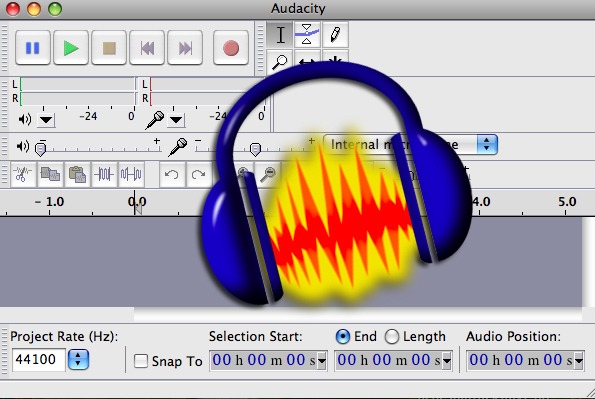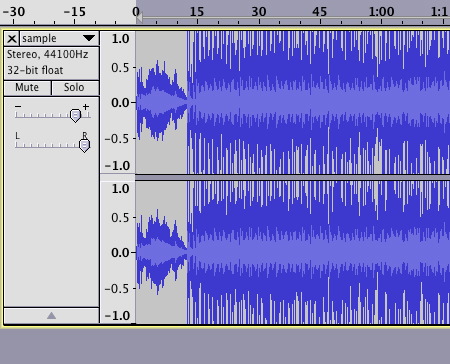

- #AUDACITY AUDIO EDITOR TUTORIAL FOR FREE#
- #AUDACITY AUDIO EDITOR TUTORIAL HOW TO#
- #AUDACITY AUDIO EDITOR TUTORIAL MOVIE#
- #AUDACITY AUDIO EDITOR TUTORIAL SOFTWARE#
- #AUDACITY AUDIO EDITOR TUTORIAL FREE#
Envelope ToolĪdjust the gain (volume) of the track or clip by placing anchor points on the ceiling and floor of the track. Move track or clip on timeline horizontally. Select ToolĬlick and drag to make a selection, then perform an operation on the selected portion of the track. Editing the trackĮditing Tools(from top-left corner to bottom-right corner) Selection tool, envelope tool (adjust volume), draw tool, magnifying tool, time shift tool, and multi-tool mode. To Import an audio file, go to File > Import > Audio and select the audio file. Click on the STOP button to stop recording. The play head will move from left to right on the timeline. If you wish to record on a previous track, select it, hold shift, and press the RECORD button. Each new recording will be created on its own timeline. To RECORD a track, click the large, red circular button and a track will appear. You can either record directly into Audacity or import audio file(s).
Open -Audacity in the Classroomĭouble click on the shortcut to open the application.Ī application will open up with no timeline displayed. #AUDACITY AUDIO EDITOR TUTORIAL FREE#
Udemy – Start Learning Audacity…For Free. Audacity Tutorial: 17 Essential Podcast Recording and Editing Tips. 10 Great ways to use Audacity with your Students. Common Sense Education lesson plans examples that incorporate Audacity. Record/edit Interviews-Capture an oral history interview. Orson Welles’s War of the Worlds-Dramatize historical event. #AUDACITY AUDIO EDITOR TUTORIAL MOVIE#
Produce a movie review audio file for other students.

Collectively produce an audiobook recording.Record speeches – evaluate performance of others or themselves to become more effective communicators.
#AUDACITY AUDIO EDITOR TUTORIAL HOW TO#
Examples of this type of project can be found in a New York Times article Project Audio: Teaching Students How to Produce Their Own Podcasts. Create podcasts – present information as a knowledge expert in a given area of their choosing or interview a knowledge expert. Promote language learning – students can record themselves and publish their recording to have others, fellow students and/or native speakers, evaluate their speaking a second language. Produce an audio advertisement (e.g., a historic scientific discovery). #AUDACITY AUDIO EDITOR TUTORIAL SOFTWARE#
Learning ActivitiesĪudacity can be utilized across disciplines, so the learning activity examples are not sorted in any specific manner to avoid a fixed perception of the possibilities of the software application. While substitution has some benefits (e.g., students develop their technology skills and knowledge), we encourage you to think about how you might use Audacity to modify or redefine learning.
Redefinition: Students remix historical recordings (or creative commons/copyright-free audio files) with new audio to generate creative sound bytes.įar too often, technology is used as a direct substitute for other low-tech tools (e.g., pencil and paper). Modification: Students engage in advanced audio editing techniques to create podcasts or other audio recordings to share with a public audience. Augmentation: Students enhance audio recordings by adding in sound effects, background music, primary source audio, and other audio files. Substitution: Students create audio recordings of their presentations rather than present in front of the class. Here is an example of how Audacity might fit within the SAMR model: As you strive to incorporate online tools into your classroom, we encourage you to use this model as an analytic tool. Ruben Puentedura’s SAMR model offers a lens for examining how technology is adopted in a classroom. Knowledge Constructor, Creative Communicatorĭr. Audacity can foster active student participation and deeper learning through content creation (e.g., podcasts) and allow students to showcase their understanding through multimedia rather than tests or papers. This application can be integrated across disciplines and is relatively easy to use. This software can: record live audio, cut, copy, splice or mix sounds together, and edit various audio files (Ogg Vorbis, MP3, WAV or AIFF to name a few). 
#AUDACITY AUDIO EDITOR TUTORIAL FOR FREE#
Audacity is an audio recording and editing software application that is open source, so anyone can download it for free with no restrictions of use.







 0 kommentar(er)
0 kommentar(er)
